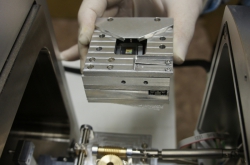It is well-known that modern transistors work at the breaking point. Their sizes have reached the limit, and, furthermore, when working they release lots of heat. It means that large amounts of energy that could be spent of useful work is simply wasted. Some researchers think that transistors have to be replaced by the far more effective elements of integrated nanophotonics. These elements will be able to process data much faster than their electronic counterparts. To create such devices, scientists have to be fluent in light managing dealing with as small scales as it possible. Roman Savelyev offers to solve this problem by using optical structures with nonlinear response.
"Nonlinear optical effects are based on the following principle: the parameters of light propagation environment depend on wave strength. Thanks to this dependence, one can observe such phenomena as optical solitons — waves that don’t change during propagation, waves generation at frequencies that differ from a frequency of propagating pulse, and many other phenomena," said Roman Savelyev.
Actually, a range of similar optical system where formation of solitons and generation of waves with new frequencies occurs has already been researched. Among them are quartz fibers, photonic crystals and silicon nano-waveguides. However, these structures a relatively big. For example, in silicon nano-waveguides, solitons are generated at wavelengths equal to several millimeters. It means that the size of optical elements and devices based on these structures will be too large to develop micro integrated optical systems.
The project by Roman Savelyev will be devoted to analysis of non-linear properties of optical nanostructures on the base of arrays of dielectric and hybrid metal-dielectric resonant nano-particles. Theoretically, they can serve as effective tools for transfer and processing data by methods of non-liner optics. Despite the fact that scientists managed to develop such nanoparticles only a short time ago, they have significant advantages, such as magnetic and electric resonance responses and spectral position that can be shifted by changing size or shape of nanoparticles. It allows to control properties of structures consisting of such particles by choosing appropriate size parameters. Furthermore, under certain conditions non-linear effects in these structures can be enhanced.




